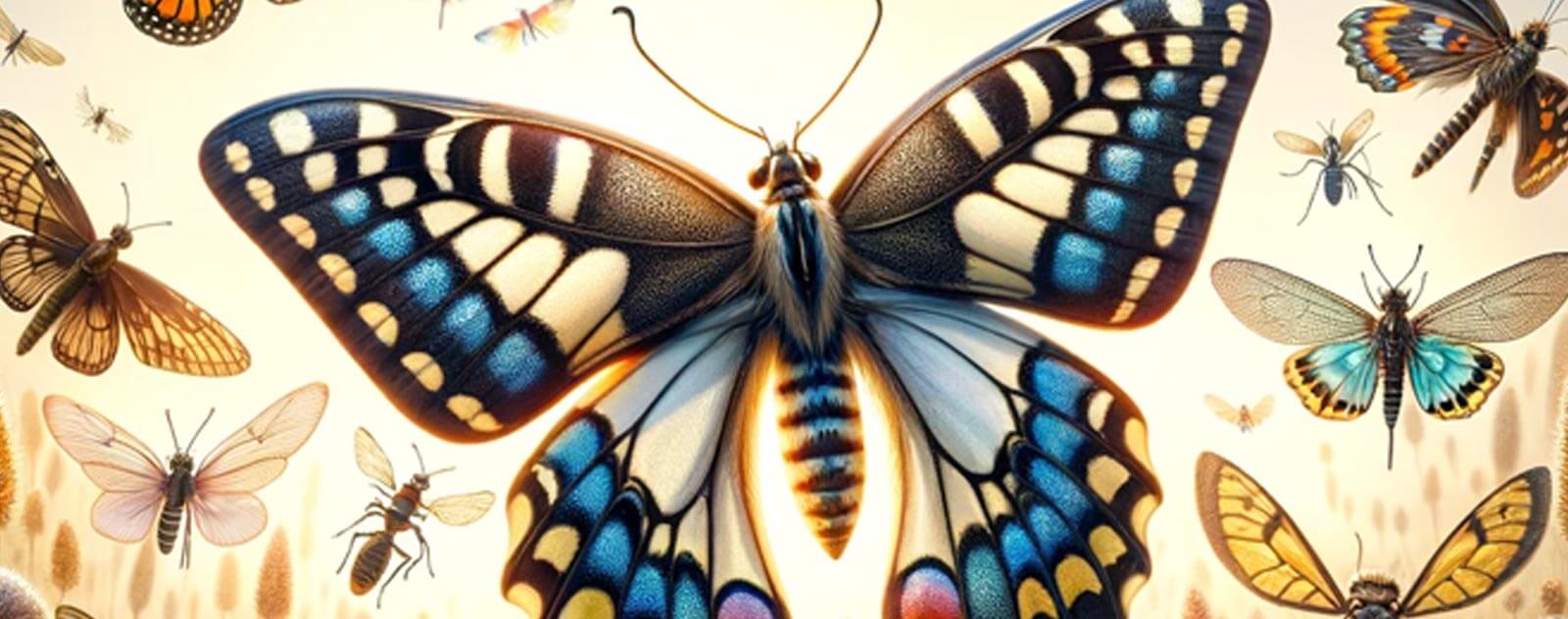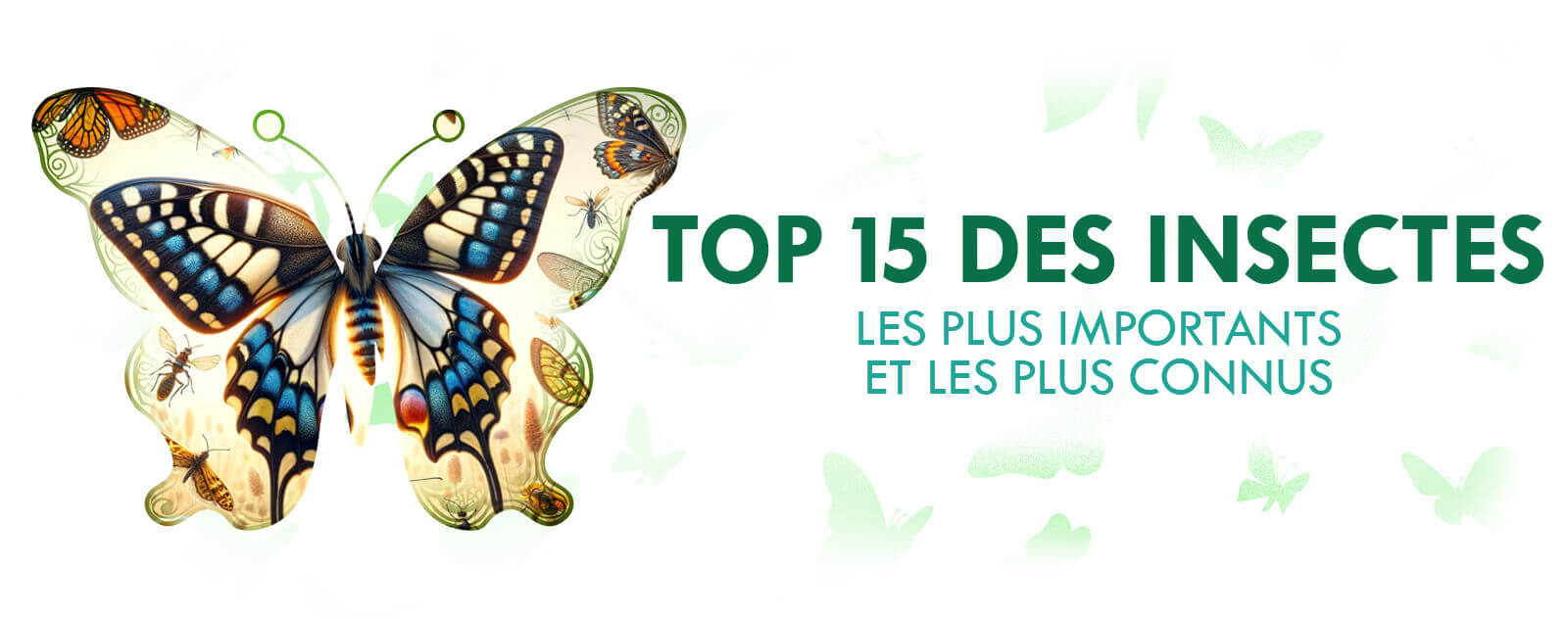Insects have inhabited our planet for millions of years, playing crucial roles in ecosystems. Some are admired for their beauty and usefulness, while others are feared for their stings or harmful potential.
Let's discover together the most important and best-known insects, exploring their diversity, their ecological importance, and the precautions to take to coexist with them.
Pollinators: Guardians of Biodiversity
The butterflies
Butterflies, with their colorful wings and graceful flight, are among the most charming insects. Their larvae, known as caterpillars, play an essential role in the food chain, while the adults help with pollination. Their preference for nectar leads them to travel from flower to flower, thus facilitating plant reproduction. However, some species of caterpillars can become harmful to crops, requiring ecological management.

The bees
Bees are crucial to the health of many ecosystems. By collecting nectar, they pollinate the flowers, playing a key role in food production. Bees also produce honey, wax, and other products beneficial to humans. Unfortunately, they are threatened by the use of insecticides and the reduction of their natural habitat, highlighting the importance of sustainable agricultural practices.
The Bumblebees
Bumblebees, with their plump bodies and characteristic buzzing sound, are effective pollinators thanks to their vibration technique to release pollen. They are particularly important for the pollination of certain plant species that require "buzz pollination." Despite their intimidating appearance, bumblebees generally only sting if provoked, and their venom is less problematic than that of other hymenoptera.
Garden Helpers: Allies against Pests
Ladybugs
Ladybugs are famous for their charming appearance and voracious appetite for aphids and other plant pests By consuming these harmful insects, they help maintain the balance of ecosystems and protect crops. The use of ladybugs as biological pest control agents is an environmentally friendly alternative to chemical insecticides.
Spiders
Although they are not insects, but arachnids, spiders deserve mention for their role in regulating insect populations. By weaving their webs, they capture and consume a wide variety of insects, including those considered harmful to humans and crops. Spiders are therefore valuable allies in the garden, contributing to a healthier environment.
The ants
Ants play a crucial role in the decomposition and dispersal of seeds. Their hard work helps aerate the soil, promoting plant health. However, some species can become invasive and cause damage, requiring careful management to prevent infestations.
Health Defenders: Prevention and Protection
Mosquitoes
Although mosquitoes are crucial to certain ecosystems as a food source for many predators, they are also known to be vectors of dangerous diseases like malaria and dengue fever. Protection against their bites, through the use of repellents and mosquito nets, is essential to prevent the transmission of these diseases.
Horseflies and Flies
Horseflies, with their ability to sting, can be more than just a nuisance. Their saliva can cause allergic reactions and, in some cases, transmit infections. It is advisable to wear protective clothing and use repellents when in areas where these insects are active.
Ticks
Ticks, although small, can be formidable parasites, feeding on the blood of their hosts and being able to transmit serious diseases such as Lyme disease. Prevention, including avoiding infested areas and regularly inspecting the skin after spending time outdoors, is key to protecting against their bites.
The Architects of Nature: Builders and Engineers
Termites
Termites, often thought of only as wood-destroying pests, actually play a vital ecological role by breaking down cellulose. This activity helps recycle nutrients in the soil, thereby enriching the habitat where they live. However, it is crucial to manage their presence in human homes to avoid significant structural damage, sometimes requiring the use of specific insecticides. Regular inspection and preventative maintenance of buildings are essential to preventing termite infestations.
Carpenter Ants
Carpenter ants are known for their ability to dig into wood to establish their nests, which can lead to structural damage in wooden constructions. Although they do not consume wood like termites, their tendency to eliminate rotten, damp wood can be an indicator of broader moisture problems that need attention. Managing moisture and wood debris around structures is crucial to preventing infestations of these insects.
The wasps
Wasps are often feared for their ability to sting, but they are also incredible architects. They build complex nests from wood fibers which they chew to create a sort of paper. These structures can grow quite large and support significant colonies. Although they are less pollinators than bees, wasps play a role in regulating insect populations, acting as predators of many pests. To avoid confrontations, it is advisable to call on professionals to manage nests located near homes.
Health Sentinels: Surveillance and Prevention
Mosquitoes and Disease Prevention
Mosquitoes are among the best-known vectors of infectious diseases, transmitting viruses such as dengue, Zika, and chikungunya. Prevention involves limiting stagnant water where mosquitoes like to lay eggs, using repellents approved by pharmacists, and installing mosquito nets.
In some areas, mosquito control campaigns are carried out to reduce mosquito populations, often using specific insecticides or biological techniques such as sterile mosquito release.
Fleas: Small Parasites
Fleas are small parasitic insects that feed on the blood of mammals and birds. They are known to be nuisances to pets, but they can also bite humans, causing itching and discomfort. Fleas can transmit diseases and parasites like tapeworms. Good hygiene of pets, regular use of antiparasitic treatments, and thorough cleaning of living spaces are essential to control flea populations.
Ticks and Disease Surveillance
Ticks are vectors of diseases such as Lyme disease and tick-borne encephalitis. They attach to the skin to feed on blood, which can last for several days. Preventing tick bites includes using repellents, wearing long clothing when walking in risky areas, and carefully examining skin and clothing after outdoor activities. If bitten, it is important to remove the tick properly and disinfect the area to minimize the risk of disease transmission.
The Guardians of the Balance: Ecological Role of Insects
Decomposer Insects: Natural Recyclers
Decomposer insects, such as certain beetles and fly larvae, play a crucial role in breaking down dead organic matter. By transforming waste into nutrients usable by other organisms, they ensure soil fertility and the maintenance of healthy ecological cycles. Although they are often seen as disgusting, their work is essential to the health of our ecosystems.
Insectivorous Predators: Natural Regulators
Insects like dragonflies, praying mantises, and some beetles are important predators of other insects, helping to naturally regulate their populations. This predation helps maintain ecological balance and reduces the need to use chemical insecticides, which can have harmful effects on the environment and biodiversity.
Insects and Biodiversity
Insect diversity and abundance are key indicators of ecosystem health. They are involved in many ecological processes, such as pollination, decomposition, and the food chain. Protecting natural habitats, reducing pollution, and adopting sustainable agricultural practices are essential to preserving this valuable insect biodiversity.
Conclusion
Insects, whether admired for their beauty and usefulness or feared for their stings and harmful potential, play indispensable roles in our ecosystems. Knowledge and understanding of these fascinating creatures allows us to better coexist with them and benefit from their presence, while minimizing the associated risks. By promoting sustainable practices and taking the necessary precautions, we can all contribute to the health of our planet and the preservation of biodiversity.





